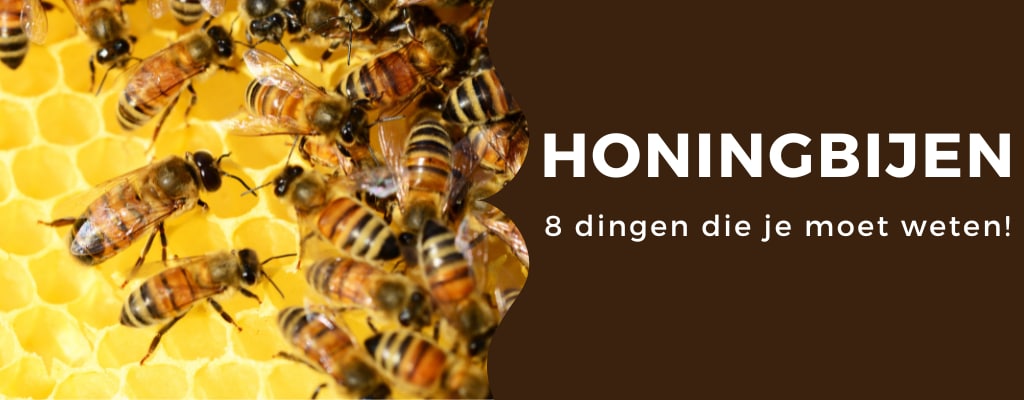8 Things You Should Know About Honeybees
It's time to get to know the honey bee better. This industrious critter has been around for millions of years, has helped humans for thousands of years and is responsible for one of the world's most popular foods: honey . We'll try to answer all your questions about honeybees so you can better understand how these fascinating insects live and work in colonies.
Contents:• How many different bees does a bee colony consist of?
• To which bee species does the honey bee belong?
• Which varieties of honey bees are found in the Netherlands?
• When and why do honey bees swarm?
• How do honeybees communicate?
• What do honey bees produce?
• How much honey does a honeybee produce in a lifetime?
• How important are honeybees for pollination?
How many different bees does a bee colony consist of?
A bee colony consists of three different types of bees: worker bees, drones and a queen. Each species takes on a different role in their society. In the worker bees, the roles also vary from birth to the end of the life phase. They are responsible for cleaning the comb cells from birth and become guards towards the end of life. The function of each type is explained below:- The worker bee (V) 5000+, who make up most of the bee population and do all the work except lay eggs. From cleaning comb cells, sweating wax to collecting nectar from flowers and then turning it into honey.
- A drone (M) 100+, a drone's only job in life is to fertilize a newborn queen bee from another hive, not his own. Mating usually takes place at an altitude of 60 meters and during mating with a queen, the drone's genitals remain inside her. He dies shortly afterwards. Around August, after all of that year's queens have fertilized, the drones are no longer welcome in the bee colony. The worker bees then move into the flight opening and block it. This is also called the drone slaughter.
- The queen bee (V) 1, is responsible for laying eggs. A queen bee mates only once, on the fifth day after birth; this process is called a nuptial flight. She can mate with one or more drones at a place called a drone staging area, where males fly around waiting for queens.
A queen bee can live up to five years, while worker bees and drones live only a few months. In the summer, worker bees live an average of six weeks. However, in winter, due to the cold temperatures in some regions, the life expectancy of these insects is only four weeks.
*V= Female, M= Male

Worker bee, drone and queen
What bee species does the honey bee belong to?
Bees are insects of the order Hymenoptera, which also includes wasps and ants. Honey bees are best known for collecting nectar and converting it into honey. Unlike other hymenopterans, which generally eat meat, bees as adults and larvae consume nectar and pollen.
The Netherlands has approximately 360 species of bees, more than half of which are threatened with extinction. About 20,000 species of bees have been identified worldwide, but there could be many more.
Many bee species live as solitary individuals, but only a few species form colonies. Among the different types of bees, a distinction can be made between eusocial and solitary bees.
- Eusocial bees are social creatures that live in colonies. These bees care for each other and depend on each other for survival.
- Solitary bees, on the other hand, live alone or in groups of only two individuals. They have no social hierarchy within their species and do not cooperate with other members of the same species to find food or shelter.
Bees are classified in the Antophila, a group that has no rank and is under the superfamily in taxonomic order. The name Antophila, which literally means "flower-worshipper" in Greek, is considered obsolete and has been replaced by the term Apiformes, which means "bee-like". Honey bees are kept by beekeepers (beekeeping) for the production of honey, propolis, royal jelly and bee pollen. In addition, in fruit cultivation for the pollination of various crops.
Which varieties of honey bees are found in the Netherlands?
The Netherlands has three popular bee varieties. The Black bee(native), Carnica and Buckfast. An expert would be able to see the external differences. There where it will still be a real challenge for the novice beekeeper. It's not just about the external differences. It is mainly the behavior of the varieties that appeals to beekeepers. In short, I will share the characteristics of each bee breed.
- Black bee ( Apis mellifera mellifera ): Native to Western Europe, survive on a small colony, swarming slow.
- Carnica ( Apis mellifera carnica ): Originating from Slovenia, gentle, honeycombed, slow to swarm and a strong drive
- Buckfast (cross between Apis mellifera ligustica and Apis mellifera mellifera ): Derived from inbreeding, extremely gentle, swarm slow and strong drive
When a purebred queen mates with a drone of an unclear race, she produces offspring called F1s. If the same thing happens again with the offspring of the F1 queen, the new queen is called an F2 nut, and so on.
When and why do honey bees swarm?
A bee colony grows so fast in the months of May, June and July that the hive in which they are located quickly becomes too small. Due to a lack of space on the one hand and a need to multiply on the other hand, the queen usually takes off with a lot of bees on a hot day. This is called a bee swarm. They suck up honey before departure to have enough honey to survive outside the hive for about 3 days. A number of orientation bees then actively look for a permanent place to settle. When they have found a suitable new space, the bee swarm flies there. In some cases, the bee swarm lands in someone's yard, a playground, etc. In this case, contact a local beekeeper who will give the bee swarm a new home.
If a bee swarm is in an inconvenient place, such as in your front yard, the bees can be removed by a local beekeeper. Although such a swarm of bees can seem intimidating, they don't even bother to sting people. Unlike wasps, honeybees die when they sting. So don't panic if one lands on you - just enjoy the wonderful creature God has made!

Bee swarm in tree
How do honey bees communicate?
Honeybees communicate with each other by dancing. With their dance, the bees tell the other bees where food is, how much pollen or nectar is needed at any given time, and where to build a new nest during a swarm.
This process is particularly useful when swarming to find a new home. The bee dance is usually divided into two types, the round dance and the wag dance. Below is a brief explanation:
- Round Dance: Source is usually within 50 meters of the bee colony
-
Wag dance: Source is usually more than 50 meters from the bee colony

Round dance and wag dance
What do honey bees produce?
Bees produce a wide variety of products. In a nutshell, the products do this:
- Honey= Winter supply
- Propolis = Protection of the bee colony
- Royal jelly= Exclusive food for the queen bee
- Bee Pollen = Food for the larvae
- Beeswax = Foundation
Explained here in detail:
Honey . The most famous product of honeybees is honey. Honeybees produce honey from the nectar they collect from flowers, usually in the form of nectar, but also from tree sap and other sources. The honey is stored in honeycombs in the beehive until it has matured enough to be used as food for humans or domesticated animals.
Propolis . Propolis is a resinous mixture collected by honey bees from the buds, leaves and bark of certain trees and plants. The propolis is used to seal cracks in the hive where drafts can enter and kill bee larvae or pupae as they develop, or to seal open cells that contain eggs or larvae parasitized by Varroa mites.
royal jelly . The queen bee uses royal jelly to create the next generation of bees. Queens are fed this substance throughout their lives, from birth to death.
Bee pollen . Honey bees produce bee pollen as a source of food for the young larvae. Bee pollen is more concentrated than bee bread and consists of only one type of pollen per grain.
Beeswax . Honeybees use beeswax to build their hives and make honeycombs. It is like cement for man.
How much honey does a honeybee produce in a lifetime?
A honey bee produces about 1/12 teaspoon in its lifetime, which is about the size of a grain of rice. That's small! It takes 700,000 bees to produce 1/2 kilogram of honey. A bee colony produces between 25 and 50 kilograms of honey per year. A honey bee visits 2 million flowers to produce 1/2 kilogram of honey.
How important are honeybees for pollination?
Studies on honeybees and other pollinators show that the world's food supply could be significantly reduced if these insects were gone. More than 75 percent of major crops grown for human consumption - including fruits, vegetables and grains - are pollinated by insects such as bees. According to the UN Food and Agriculture Organization, insects play a critical role in the pollination of some of our major crops, which provide more than $153 billion a year in food. In addition, pollinators contribute more than $29 billion to the added value of the global economy.
“If the bee disappears from the surface of the earth, man will have only four years to live.” —Albert Einstein.
Bees are essential for fruit growing. Pears, apples and strawberries could not exist without pollination. Strawberry fields that are properly pollinated produce up to one and a half times more strawberries than fields without pollination. Apples and pears grown in orchards with high levels of pollination are larger, but bees also play an important role in other types of agriculture. They play an important role in the pollination of vegetables and legumes (such as beans and peas), which rely on animal agents to carry their pollen from flower to flower.










Leave a comment
Please note, comments need to be approved before they are published.